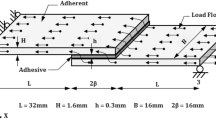Abstract
The fatigue de-bond growth studies have been conducted on adhesively bonded lap joint specimens between aluminium and aluminium with Redux-319A adhesive with a pre-defined crack of 3 mm at the bond end. The correlations between fracture parameters and the de-bond growth data are established using both numerical and experimental techniques. In the numerical method, geometrically non-linear finite element analyses were carried out on adhesively bonded joint specimen for various de-bond lengths measured from the lap end along the mid-bond line of the adhesive. The finite element results were post processed to estimate the SERR components G I and G II using the Modified Virtual Crack Closure Integral (MVCCI) procedure. In experimental work, specimens were fabricated and fatigue de-bond growth tests were conducted at a stress ratio R = − 1. The results obtained from both numerical analyses and testing have been used to generate de-bond growth curve and establish de-bond growth law in the Paris regime for such joints. The de-bond growth rate is primarily function of mode-I SERR component G I since the rate of growth in shear mode is relatively small. The value of Paris exponent m is found to be 6.55. The high value of de-bond growth exponent in Paris regime is expected, since the adhesive is less ductile than conventional metallic materials. This study is important for estimating the life of adhesively bonded joints under both constant and variable amplitude fatigue loads.
Similar content being viewed by others
References
ASTM D 3165 1997 Standard test method for strength properties of adhesives in shear by tension loading of single-lap-joint laminated assemblies. Annual Book of ASTM Standards 15.06: 199–202
ASTM E 647–93 1993 Standard test method for measurement of fatigue crack growth rates. Pennsylvania American Society for Testing and Materials, Philadelphia
Brussat T R, Chiu S T, Mostovoy S 1977 Fracture mechanics for structural adhesive bonds-final report AFML-TR-77–163, Air Force Materials Laboratory, Wright-Patterson AFB, Ohio
Curley A J, Hadavinia H, Kinloch A J, Taylor A C 2000 Predicting the service-life of adhesively-bonded joints. Int. J. Fract. 103: 41–69
Dattaguru B, Everett R A Jr, Whitcomb J D, Johnson W S 1984 Geometrically nonlinear analysis of adhesively bonded joints. J. Eng. Mater. Technol. 106: 59–65
Ewalds H L, Wanhill R J 1984 Fracture mechanics. London, UK: Edward Arnold
Forman R G, Kearney V E, Engel R M 1967 Numerical analysis of crack propagation in cyclic-loaded structures. J. Basic Eng, Trans. ASME 89: 459–463
Hosseini-Toudeshky H, Mohammadi B, Bakhshandeh S 2007 Mixed-mode fatigue crack growth of thin aluminium panels with single-side repair using experimental and numerical methods. Fatigue Fract. Eng. Mater. Struct. 30(7): 629–639
Kinloch A J, Osiyemi S O 1993 Predicting the fatigue life of adhesively bonded joints. J. Adhesion 43: 79–90
Lin C, Liechti K M 1987 Similarity concepts in the fatigue fracture of adhesively bonded joints. J. Adhesion 21: 1–24
Mandell J F, Meier U 1983 Effects of stress ratio, frequency and loading time on the tensile fatigue of glass-reinforced epoxy. In: T K O’Brien ed., Long-term behaviour of composites, ASTM STP 813, ASTM International, West Conshohocken, PA, pp. 55–77
Meguid S A 1989 Engineering fracture mechanics. London, UK: Elsevier Science Publishers Ltd.
Mostovoy S, Ripling E J 1975 Flaw tolerance of a number of commercial and experimental adhesives. Adhesion science and technology, L H Lee (ed) 9. B, Plenum Press, NY, pp. 513–562
Paris P C, Erdogan F 1963 A critical analysis of crack propagation laws. J. Basic Eng Trans. ASME 85: 528–534
Ramamurthy T S, Krishnamurthy T, Badari Narayana K, Vijayakumar K, Dattaguru B 1986 Modified crack closure integral method with quarter point elements. Mech. Res. Commun. 13(4): 179–186
Rybicki E F, Kanninen M F 1977 A finite element calculation of stress intensity factor by modified crack closure integral. Eng. Fract. Mech. 9: 931–938
Sahoo P K, Dattaguru B, Manjunatha C M 2007 A parametric study of mixed-mode strain energy release rate components at de-bonds in adhesively bonded composite joints. International and INCCOM-6 conference on future trends in composite materials and processing, IIT Kanpur, India, December 12–14
Author information
Authors and Affiliations
Corresponding author
Rights and permissions
About this article
Cite this article
SAHOO, P.K., DATTAGURU, B., MANJUNATHA, C.M. et al. Fatigue de-bond growth in adhesively bonded single lap joints. Sadhana 37, 79–88 (2012). https://doi.org/10.1007/s12046-012-0067-3
Published:
Issue Date:
DOI: https://doi.org/10.1007/s12046-012-0067-3




